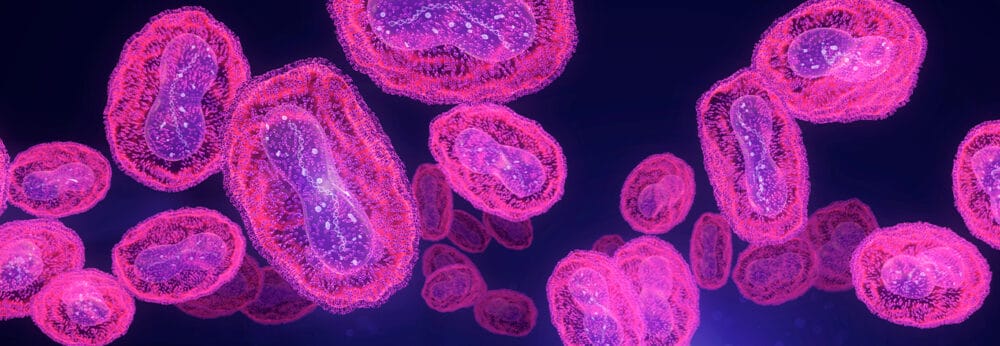Posted
31st October 2024
Research
Introduction
Norovirus is recognised as the leading cause of viral gastroenteritis in the United Kingdom, responsible for over 50% of all gastroenteritis outbreaks1. Often termed the “winter vomiting bug,” norovirus poses significant challenges due to its high infectivity and environmental resilience.
Virology and infectivity
Norovirus belongs to the family Caliciviridae and is a non-enveloped, single-stranded RNA virus2. Remarkably infectious, as few as 10 to 100 viral particles can cause infection in humans3,4. Its incubation period ranges from 12 to 48 hours, with symptoms typically lasting one to three days5.
Transmission routes
Transmission of norovirus primarily occurs via the faecal-oral route6:
- Person-to-person contact: Direct interaction with an infected individual facilitates spread7.
- Contaminated food and water: Ingestion of virus-laden food or beverages8.
- Fomites: Contact with contaminated surfaces can lead to hand-to-mouth transfer9.
- Aerosolisation: Vomiting can aerosolise viral particles, leading to inhalation and subsequent ingestion10.
Environmental persistence
Norovirus exhibits remarkable stability in the environment. Studies have shown that it can survive on surfaces for up to two weeks and remain viable in water for several months11. The virus is resistant to common disinfectants and can withstand a range of temperatures and pH levels12.
Hand transfer and surface contamination
Contaminated hands can transfer norovirus to up to seven clean surfaces, perpetuating the cycle of infection13. This highlights the critical role of hand hygiene and environmental cleaning in controlling outbreaks.
Hand hygiene: limitations of alcohol-based hand rubs
While alcohol-based hand rubs (ABHR) are effective against many pathogens, they are less effective against non-enveloped viruses like norovirus14,15. The lipid envelope targeted by alcohol in enveloped viruses is absent in norovirus, reducing ABHR’s virucidal activity.
Importance of hand washing with soap and water
The UK Health Security Agency (UKHSA) and World Health Organization (WHO) recommend thorough hand washing with soap and water as the most effective method for removing norovirus from hands.16,17 Mechanical action during hand washing helps dislodge and rinse away viral particles.

Surface disinfection
Efficacy of disinfectants
Effective disinfection requires agents that are proven to inactivate norovirus. Disinfectants should meet the requirements of the European Standard EN 14476, a prescribed method of demonstrating effective virucidal activity against norovirus under dirty conditions (i.e., in the presence of organic matter) and with realistic contact times18.
Clinell Universal Wipes: Meeting EN 14476 Standards
Clinell Universal Wipes are combined detergent and disinfectant wipes that have shown efficacy against norovirus. They comply with EN 14476 under dirty conditions with a contact time of 60 seconds19. This makes them a practical choice for surface decontamination in both healthcare and community settings.

Preventive measures
Hand hygiene practices
- Wash hands frequently with soap and water for at least 20 seconds, especially after using the toilet and before eating or preparing food16.
- Avoid relying solely on ABHR, especially during norovirus outbreaks.
Environmental cleaning
- Use disinfectants effective against norovirus, ensuring they meet EN 14476 standards18.
- Pay special attention to high-touch surfaces like door handles, taps, and toilet flush handles20.
Isolation and exclusion
- Exclude symptomatic individuals from work, school, or social gatherings until 48 hours after symptoms have resolved21.
- In healthcare settings, isolate infected patients to prevent nosocomial transmission22.
Food safety measures
- Implement strict hygiene protocols in food handling and preparation8.
- Ensure shellfish and other high-risk foods are cooked thoroughly to inactivate the virus.

Conclusion
Norovirus remains a formidable public health challenge due to its high infectivity and environmental robustness. Emphasising the limitations of ABHR against norovirus, it is imperative to promote hand washing with soap and water and the use of effective disinfectants that meet EN 14476 standards. Through diligent hygiene practices and appropriate environmental cleaning, the spread of norovirus can be significantly mitigated.
1. Lopman BA, Vennema H, Kohli E, et al. Increase in viral gastroenteritis outbreaks in Europe and epidemic spread of new norovirus variant. Lancet. 2004;363(9410):682-688.
2. Green KY. Caliciviridae: The Noroviruses. In: Fields Virology. 6th ed. Lippincott Williams & Wilkins; 2013.
3. Teunis PF, Moe CL, Liu P, et al. Norwalk virus: how infectious is it? J Med Virol. 2008;80(8):1468-1476.
4. Atmar RL, Estes MK. The epidemiologic and clinical importance of norovirus infection. Gastroenterol Clin North Am. 2006;35(2):275-290.
5. MacCannell T, Umscheid CA, Agarwal RK, et al. Guideline for the prevention and control of norovirus gastroenteritis outbreaks in healthcare settings. Infect Control Hosp Epidemiol. 2011;32(10):939-969.
6. Hall AJ, Vinjé J, Lopman B, et al. Updated norovirus outbreak management and disease prevention guidelines. MMWR Recomm Rep. 2011;60(RR-3):1-15.
7. Matthews JE, Dickey BW, Miller RD, et al. The epidemiology of published norovirus outbreaks: a review of risk factors associated with attack rate and genogroup. Epidemiol Infect. 2012;140(7):1161-1172.
8. Food Standards Agency. Norovirus and food handlers: guidance. 2020. https://www.food.gov.uk/safety-hygiene/norovirus
9. Barker J, Vipond IB, Bloomfield SF. Effects of cleaning and disinfection in reducing the spread of norovirus contamination via environmental surfaces. J Hosp Infect. 2004;58(1):42-49.
10. Marks PJ, Vipond IB, Regan FM, et al. A school outbreak of Norwalk-like virus: evidence for airborne transmission. Epidemiol Infect. 2003;131(1):727-736.
11. Boone SA, Gerba CP. Significance of fomites in the spread of respiratory and enteric viral disease. Appl Environ Microbiol. 2007;73(6):1687-1696.
12. Tuladhar E, Hazeleger WC, Koopmans M, et al. Residual viral and bacterial contamination of surfaces after cleaning and disinfection. Appl Environ Microbiol. 2012;78(21):7769-7775.
13. Julian TR, Leckie JO, Boehm AB. Virus transfer between fingerpads and fomites. J Appl Microbiol. 2010;109(6):1868-1874.
14. Kampf G. Efficacy of ethanol against viruses in hand disinfection. J Hosp Infect. 2018;98(4):331-338.
15. Warren-Gash C, Fragaszy E, Hayward AC. Hand hygiene to reduce community transmission of influenza and acute respiratory tract infection: a systematic review. Influenza Other Respir Viruses. 2013;7(5):738-749.
16. UK Health Security Agency. Norovirus: guidance, data and analysis. 2022. https://www.gov.uk/government/collections/norovirus-guidance-data-and-analysis
17. World Health Organization. Guidelines on Hand Hygiene in Health Care. 2009. https://www.who.int/publications/i/item/9789241597906
18. European Committee for Standardization. EN 14476:2013+A2:2019 Chemical disinfectants and antiseptics – Quantitative suspension test for the evaluation of virucidal activity in the medical area. 2019.
19. Clinell. Clinell Universal Wipes Product Information. 2021. https://gamahealthcare.com/products/universal-range
20. Public Health England. Guidelines for the management of norovirus outbreaks in acute and community health and social care settings. 2012. https://assets.publishing.service.gov.uk/government/uploads/system/uploads/attachment_data/file/322943/Guidance_for_managing_norovirus_outbreaks_in_healthcare_settings.pdf
21. National Health Service. Norovirus (vomiting bug). 2021. https://www.nhs.uk/conditions/norovirus/
22. Chadwick PR, Trainor E, Marsden GL, Mills S, Chadwick C, O’Brien SJ, Evans CM, Mullender C, Strazds P, Turner S, Weston V, Toleman MS, de Barros C, Kontkowski G, Bak A. Guidelines for the management of norovirus outbreaks in acute and community health and social care settings. J Hosp Infect. 2023 Jun;136:127-191. doi: 10.1016/j.jhin.2023.01.017. Epub 2023 Feb 15. PMID: 36796728.
SHARE THIS ARTICLE
Tags
Latest News
Norovirus: Understanding its transmission and prevention in the UK
Introduction Norovirus is recognised as the leading cause of viral gastroenteritis…
Clean Between to Reduce Healthcare-Associated Infections
Healthcare-associated infections (HAIs) are a significant concern for healthcare facilities…
Mpox: emergence of a new threat
A new threat related to mpox is emerging, in the…
Wiping away infections – the CLEEN way!
Cleaning shared medical equipment with a disinfectant wipe at least…





